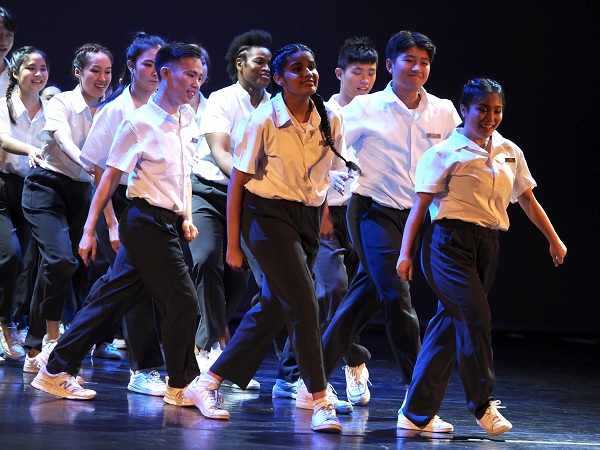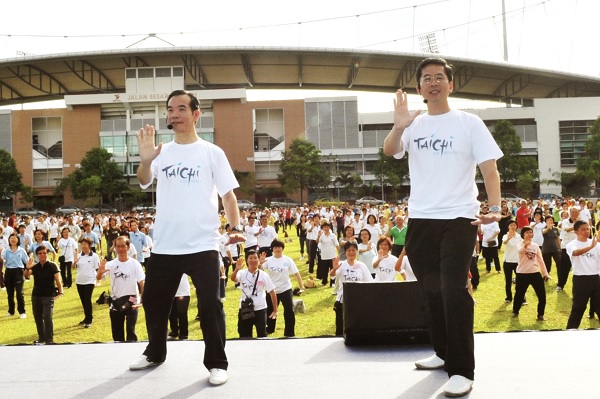Featuring men from our profession who put on a different "robe" when they take off their doctor's gown for the day. These doctors share the extra mile they go in leading enriching and fun-filled lives while pursuing their passions outside of work.
Hing Siong Chen
I first took up recreational cycling in 2005. As I recall, my initial motivation was that I had a body mass index over the healthy range, with a touch of hypertension and hypercholesterolaemia. This later led to my foray into triathlons and racing, and I have not looked back since. Four Ironman triathlons later, I finally settled into a love for competitive cycling and bicycle-touring around the world with my better half. I continue to race in road and gravel bike events and have raced competitively with local and regional teams like the Lapierre Asia Racing Team. On weekends, I ride with local cycling club Team Cycledelic.
Cycling has become part of my life and has given me immense freedom and a sense of being with nature. It has helped me to connect with people from all walks of life and cultures. In fact, what I really look forward to are the coffee sessions after my ride – there are so many wonderful spots in Singapore and around the world to explore. Apart from the obvious health and social benefits, I also wanted to see the world on my trusty bicycle with my wife Lynette, who is an oncologist. Over the past few years, we have toured many exotic and out-of-the-way locations on our two wheels.
Beyond an athlete
My involvement with the Singapore Cycling Federation (SCF) was a decision made on the spur of the moment. In 2015, I was approached by the former honorary secretary of SCF and invited to be part of a team of volunteers to help manage this national sports association. At that time, I did not know much about what the task entailed. I remember offering to go on a weekly Friday afternoon ride with the two full-time staff of the SCF, thinking that apart from organising a few local cycling competitions annually, there was not much else for me to do. I also did not know much about the complexities of the local and international sporting ecosystems then and had even wrongly assumed that the appointment would allow me to cycle on a more regular basis! My first two years leading the Federation were eye-opening and presented a steep learning curve for me. In today's world, managing a not-for-profit organisation like the SCF is a full-time job and it must be run professionally with clear long-, mid-and short-term measurable objectives.
Eight years on, SCF has grown into a large family with fifteen full-time staff and as many part-time coaches. We also have over 100 national development athletes (athletes enrolled in our high performance programmes, including the national riders, national training squad and national development squad riders), and a diverse and dynamic Board leading the Federation.
From the beginning, teamwork, caring and sharing have been the pillars upon which we have built our foundations.
Cycling for a greater purpose
There continue to be immense growth opportunities for cycling as a sport to inspire the Singapore spirit, as a healthy lifestyle pursuit and as an eco-friendly mode of transport. Cycling has also brought our community together to rouse hope and raise funds for charitable causes. As a charity, we feel that it is important to support other charities in need. This year, SCF will be organising our second edition of the Cycle for Hope fundraiser to raise awareness of cancer and funds for needy patients and their families. You can find out more at https:// www.cycleforhope.sg. I would like to take this opportunity to thank all the medical groups and doctors in our fraternity who have been supporting our cause.
I hope that through my sharing, I have in some way ignited a spark of curiosity in all of you to explore and dedicate a small part of life to chasing your own passions and making a positive impact with the people you will connect with.

Teaching cycling as a life skill and nurturing our future talents at our SCF Children's Academy
Lim Yun Xue
I took my first official dance class in 2019 when I was still in National Service (NS). As NS life became more routine over time, I started thinking about picking up a new skill to pass the time. Having always wanted to try dance, I felt it was opportune then to give it a shot. I started off with hip-hop dance, but nowadays I have moved towards open choreography dancing.
Perks of dancing
Dance is a great way to make new friends and get to know people from all walks of life. The people I have met in dance are generally very friendly and encouraging. I also find dance to be a safe space to make mistakes and grow, and an avenue to build your confidence. There are many opportunities during class to perform a small-group choreography in front of a crowd.
To me, dancing is an enjoyable form of exercise and I have continued to see dance as my main form of exercise. After standing for long hours during ward rounds or sitting at my desk for extended study periods, dancing is a great way to loosen up all the stiff muscles and get blood flowing to all parts of the body. But beyond that, when studying gets a little overwhelming, dance becomes my stress reliever. It breaks the monotony of clinicals every day, and it gives me more motivation to get through the week.
Having the right mindset
Without a doubt, there were many dance opportunities I have had to forgo as I had to prioritise medical school. At the end of the day, the ability to commit to both medical school and dance requires planning. As we students receive our academic calendars at the start of the year, we have a general gauge of when our busier and freer periods are. From there, I can determine which periods in our academic year I can better commit to dance in. Also, the proportion of time allocated between dance and medical school does not have to be static, nor does it have to be equal. Going for one or two one-hour open classes per week is an acceptable balance for me. During busy periods, I might reduce this frequency to one class fortnightly. The frequency then increases during times such as the postexamination period. With early planning (and a little bit of luck, as different studios have different production schedules), it is very possible to commit to dance recitals as well.
Within the academic year 2022/2023, I took part in two dance recitals from external studios, the first being with STEP Studio in September 2022 and the second being with O School in March 2023. Depending on the studio, trainings could happen around once to twice a week, lasting around two to three hours each. The choreographer might also call for more self-practice sessions in addition to the usual schedule when the performance date is around the corner. Closer to the actual performance date, we would also be required to commit more time for the full-dress rehearsals and stage-blocking sessions.
I think one important thing to have is the ability to toggle our mindsets well, as we move between our commitments. When I enter a dance class, I try to put aside the stressors from medical school and really enjoy that hour or two in class. The converse is true with focusing during the medical curriculum. Overall, it is very possible to pursue interests outside of medical school so long as we have proper planning and the right mindset when going into them.

Performing as part of the Step Recital 2022
Lau Tang Ching
From an early age, I developed a profound connection with Tai Chi exercise, or 太极拳 in Chinese. My father, an ardent Tai Chi practitioner, introduced me to this traditional Chinese martial art at the Kallang Community Centre when I was in Primary 4. This pivotal moment not only ignited within me a lifelong passion for Tai Chi but also kindled a keen interest in other martial arts like Shaolin, Xing Yi Quan (形意拳) and Tan Tui, which I diligently pursued until my enlistment in National Service.
Holistic self-care
Tai Chi offers valuable benefits that complement the busy lifestyle of practising doctors. It provides stress relief, promotes physical health, enhances mindfulness and focus, and facilitates self-care. The gentle movements and mindfulness techniques of Tai Chi can help doctors on a holistic level and foster personal well-being. Incorporating Tai Chi into our lives can help us find a sense of balance, manage stress and maintain physical health amid our hectic work. As a rheumatologist with a special interest in osteoporosis management, falls and fracture prevention, I also recognise the significance of Tai Chi's advantages in my field.
One of the key benefits of Tai Chi is its positive impact on muscle strength, balance and flexibility. By improving muscle tone and balance, Tai Chi helps reduce the risk of falls,1 a crucial concern for doctors dealing with injury and fracture prevention. Additionally, Tai Chi aids in relieving joint pain and improving joint function in cases of osteoarthritis,2 a condition caused by weakened muscles that leaves joints susceptible to damage and accelerated wear and tear. Strengthening muscles and enhancing flexibility through Tai Chi exercise can contribute to healthier joints and mitigate the onset of osteoarthritis.
Passing on the art
With the significant scientific evidence, the National Arthritis Foundation collaborated with Dr Paul Lam, a Tai Chi expert and GP in Sydney, Australia, to introduce Tai Chi exercise to the Singaporean public from 2008. I began to teach this exercise weekly in Bishan Park, online via webinars during the COVID-19 pandemic, and also conduct continuing education and training courses in the National University of Singapore. Through these courses, I share my passion for Tai Chi and train others to become instructors to promote this exercise and spread its benefits to more people.
In conclusion, Tai Chi is a useful exercise that complements the busy lifestyle of practising doctors. Its benefits align closely with the demands and challenges doctors face in their profession. My personal journey with Tai Chi and subsequent dedication to sharing its benefits through education and training programmes reflect the significant impact it can have on the well-being and effectiveness of medical professionals. By embracing this ancient practice, doctors can enhance their overall well-being and approach their profession with renewed energy and fulfilment.
"Exercise is the best medicine, and Tai Chi is one excellent form of exercise."
PS: For readers who are interested in learning Tai Chi exercise via online videos, please refer to the following link: https://naf.org.sg/taichi-lessons/. For readers who are interested in being trained as Tai Chi instructors, please refer to the following link: https://bit. ly/3O3g8jy.

Dr Paul Lam (left) and Prof Lau (right) leading a mass Tai Chi exercise session in 2010